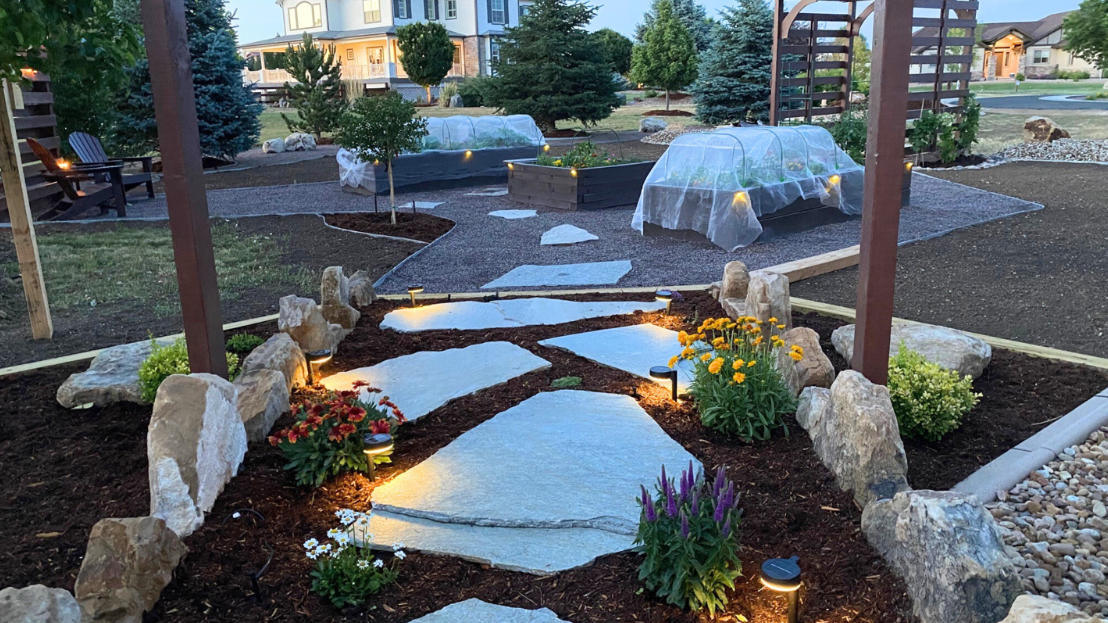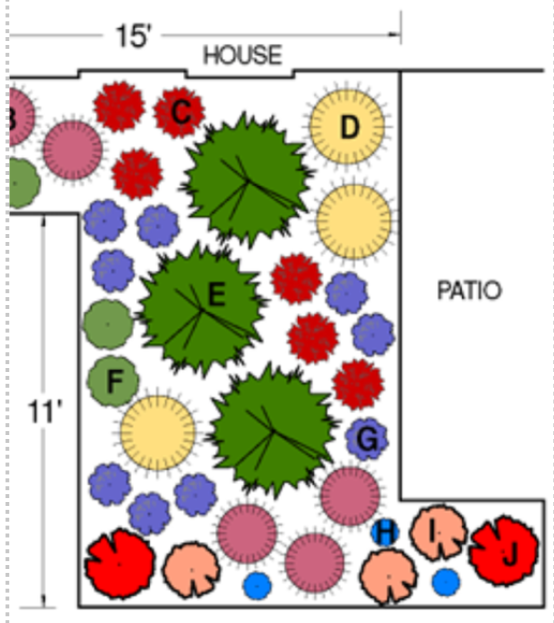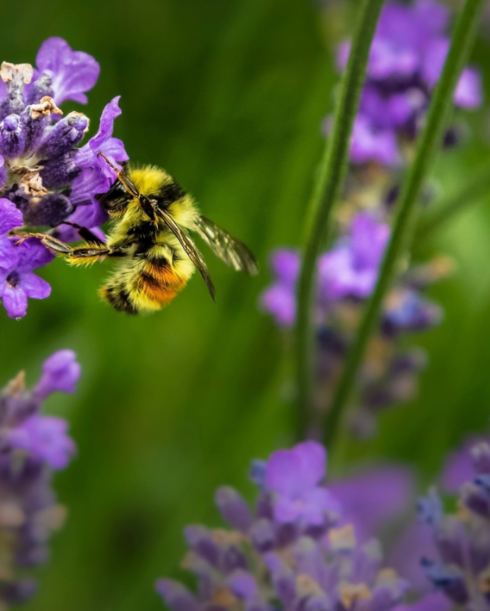Create the Ultimate Water-Wise Yard and Stay Under Your Allotment
June 1, 2025

Creating a yard you love shouldn't come at the expense of your water budget or our shared water supply. A water-wise landscape not only helps you stay under your monthly water allotment, but it also supports long-term conservation and reduces your water bill. With the right tools and thoughtful changes, you can grow a beautiful, vibrant outdoor space that thrives in Colorado’s climate without exceeding your limit.
Creating a yard you love shouldn't come at the expense of your water budget or our shared water supply. A water-wise landscape not only helps you stay under your monthly water allotment, but it also supports long-term conservation and reduces your water bill. With the right tools and thoughtful changes, you can grow a beautiful, vibrant outdoor space that thrives in Colorado’s climate without exceeding your limit.
Here’s how to get started:
Track Your Water Use with EyeOnWater
Before you make changes to your yard, it's helpful to know exactly how much water you're using and where it's going. That’s where EyeOnWater comes in. This free website and mobile app allows you to see your consumption hourly, daily, monthly and annually to gain visibility into your water usage trends. It also allows you to have more visibility into whether you’re close to going over your annual allotment. Not sure what your allotment is? You can find it on your bill below the bar graph that shows your monthly usage. You can find the bill highlighted with key areas on our Understanding Your Bill page as well.
If you’re still having trouble determining your allotment, feel free to call us at (970) 532-2096 or fill out the contact form on our website. You can also learn more about the surcharges associated with going over your allotment on our Rates, Charges and Allotments page. EyeOnWater is available to most of our customers. However, a few areas on the far west side of our district are too remote to have the smart meter required to use this app. Check the Beacon Coverage Zone Map if you’re unsure about your meter type.
Schedule a Free Slow the Flow Sprinkler Evaluation
Even the most beautiful yards can waste water if sprinklers are misaligned, leaking or running too long. We’ve partnered with Resource Central to offer free sprinkler evaluations through the Slow the Flow program. A trained technician will come to your home, inspect your irrigation system and provide recommendations for watering more efficiently, saving you water and money. They also teach customers how to adjust their sprinkler clocks too. Sprinkler systems aren’t meant to be a set it and forget it feature, so this program is perfect for people who have questions about how to operate their sprinkler system effectively. Each summer, our customers fill up all our allotted slots, so schedule your evaluation now to avoid missing out!
LTWD Pro Tip: Many of our customers see great results from their sprinkler evaluation in the first year. Unfortunately, many of our customers seem to forget their new habits and fail to implement the recommendations they received in the following years. Remember, if you want to see continued savings each year, you must continue practicing what you learned during your sprinkler evaluation!
Follow the 1-2-3-2-1 Watering Schedule
Outdoor watering needs change with the weather, so your watering schedule should change too. A sprinkler system is not meant to be a “set-it-and-forget-it” feature of your home. We recommend tapering your watering schedule up and down with the average temperatures to use water efficiently. A practical guideline is the 1-2-3-2-1 schedule:
- Water 1 day per week: Early spring, roughly early May through May 22, average temp less than 70°F
- Water 2 days per week: Early summer, roughly May 23 through June 16, average temps between 70°F and 85°F
- Water 3 days per week: Mid-summer, roughly June 17 through August 22, average temp above 85°F
- Water 2 days per week: Late summer, roughly August 23 through September 23, average temps between 70°F and 85°F
- Water 1 day per week: Fall, roughly September 24 through sprinkler blowout, average temp less than 70°F
Watering more than this not only wastes water but can also harm your plants by encouraging shallow roots and disease.
Water on Your Assigned Days and Follow the Water Shortage Contingency Plan
Following the rules designed to protect our shared water resources can help you stay within your allotment as well. That includes watering only on your assigned days and complying with all other requirements in our Water Shortage Contingency Plan.
As of April 2025, we are in the green “Water Shortage Watch” level of the plan. The following guidelines are in place under the “watch” level
Watering Hours: Please water only before 10 AM or after 6 PM
Watering Days: Maximum 3 days per week. (Note: You are not required to water 3 days per week; that is simply the maximum. As mentioned above, during certain months of the irrigation season, we actually suggest watering just one or two days per week.
- Even-numbered addresses: Monday, Wednesday, Saturday
- Odd-numbered addresses: Tuesday, Thursday, Sunday
Trees and Bushes: Limited to drip systems, hand watering with shut-off nozzle, deep root needle, or arbor bag
Gardens and Greenhouses:
- If using sprinklers: Follow the 3-day schedule before 10 AM or after 6 PM
- If hand watering, use a deep root needle or drip system: No day restrictions

Group Plants with Similar Needs
Intentional plant placement goes a long way toward efficient watering. Grouping plants with similar water and sunlight needs, also called hydrozoning, allows you to water more effectively and avoid overwatering or underwatering parts of your yard.
Not sure where to start? Plant Select®, a non-profit collaboration from Colorado State University, Denver Botanic Gardens and Professional Horticulturists, has over 10 free water-wise landscape designs in a “Plant by Letter” format to easily duplicate the designs at home.
Choose Water-Wise Plants from Trusted Sources
When adding new plants to your yard, ensure they’re a good fit for Colorado’s dry climate. Water-wise plants are more resilient to drought and require far less irrigation once established.

Some great resources for water-wise plants include:
- Garden In A Box – Pre-planned kits from Resource Central include low-water plants and a planting guide. Resource Central does a spring and late summer release, and they always sell out fast. Make sure you don’t miss out by getting on their interest list. Each year, LTWD provides a discount for a limited number of boxes for members of our district. If our discounts run out, you can still purchase full-price boxes directly from Resource Central.
- Plant Select® – As mentioned above, Plant Select is a nonprofit collaboration on a mission to breed and sell plants designed to thrive in high plains and intermountain regions. It offers plants that provide more beauty with less work, so gardeners of all levels can achieve successful gardens using fewer resources and with a positive environmental impact. Look for their label at local nurseries or explore options at plantselect.org.
LTWD Pro Tip: Plant Select plants do tend to come with a higher price tag. While Garden In A Box kits come at a great price point, they sell out quickly every year! If neither of those options work out for you, you can always ask workers at your favorite nursery to help you find Colorado-native or low-water plants without the Plant Select label, and these will typically be a little cheaper and easier to find.
Show Off Your Water-Wise Yard
If you make any of these updates to create a more sustainable, water-wise yard this year, don’t keep it to yourself—enter our annual Water-Wise Landscape Contest! It’s a great way to celebrate your hard work, inspire neighbors and even win prizes. Whether you’ve replaced turf with low-water plants, added efficient irrigation, or redesigned your yard for beauty and conservation, we want to see it.
The entry deadline is October 15, 2025, and landscapes must be planted before June 15 or after September 15, or have been originally planted within the past two years to be eligible. If you're planning any changes this year, now’s the perfect time to get started!
Why Mindful Watering Really Matters
We know you want to avoid surcharges and stay under your allotment, but that doesn’t mean giving up on a beautiful yard. With the right strategies and resources, you can enjoy a colorful, low-maintenance and water-smart landscape that adds value to your home and joy to your summer.
However, there is a bigger picture to remember besides your watering bill. This summer is expected to be drier. Our Water Resources Manager, Amanda Hoff, shared,
“Little Thompson Water District has a good water supply for this year, so we don’t need to raise any alarms. However, we all must use best practices to prevent the need to step up to the next level of water restrictions. Water in Colorado is a precious resource, and it takes each one of our customers doing their part to protect our water supply.”
Thank you for your efforts in conserving water. We applaud any steps you take to create a more water-wise landscape at your home. Your changes will protect your wallet, too, as you can avoid the surcharges associated with going over your allotment.
If you have any questions about your allotment, please refer to your bill. If you have any other questions about the tips shared in this blog, contact us at (970) 532-2096 or fill out the contact form on our website.
